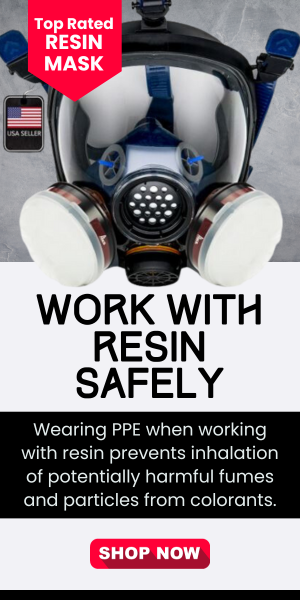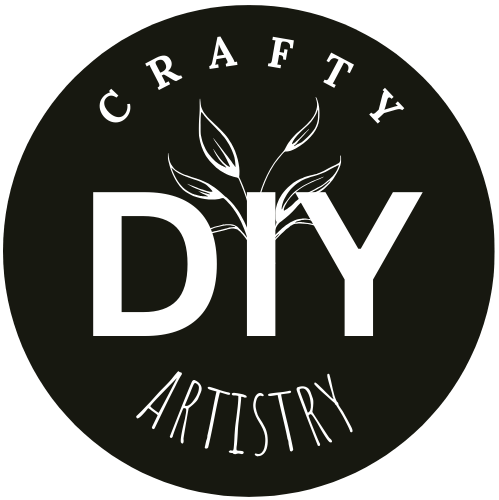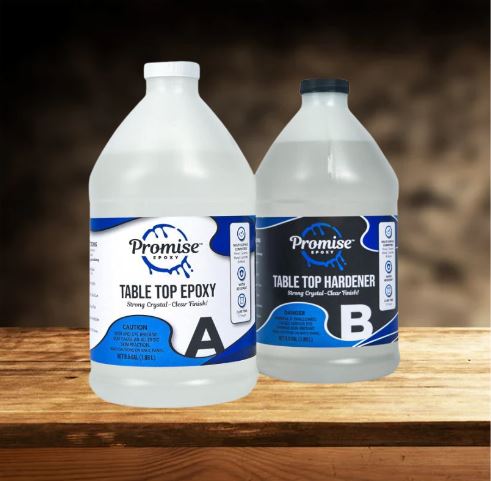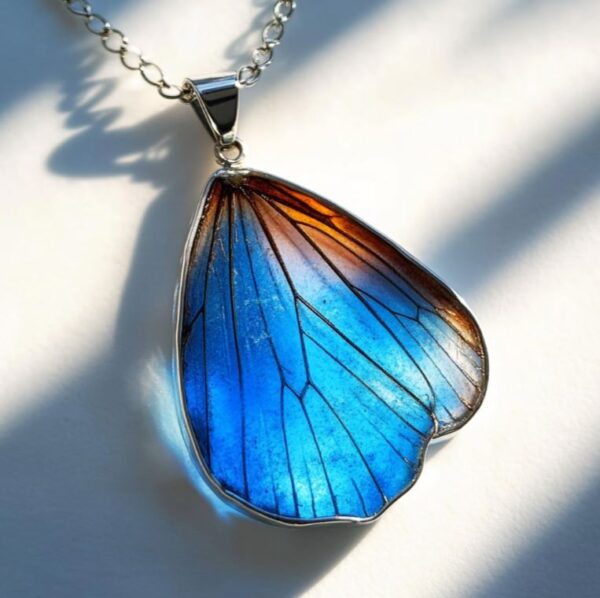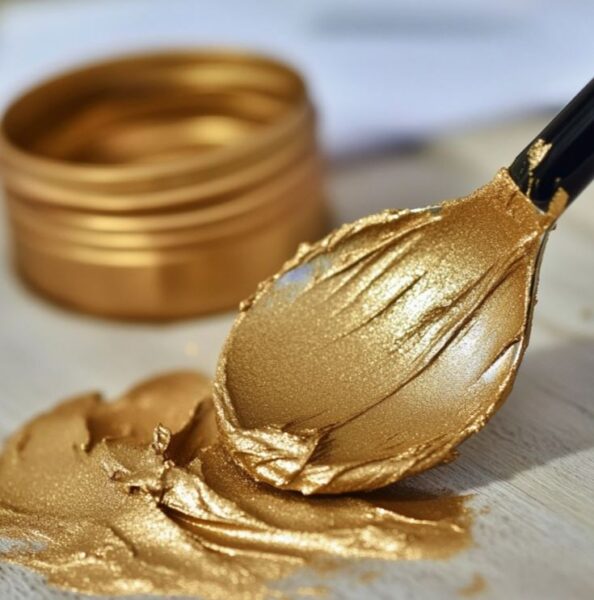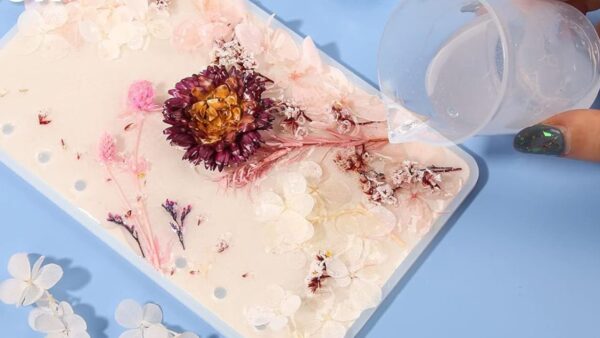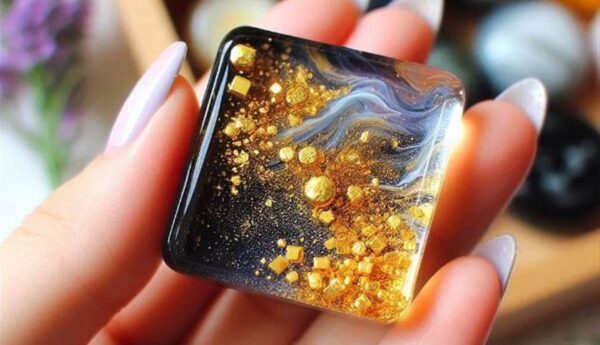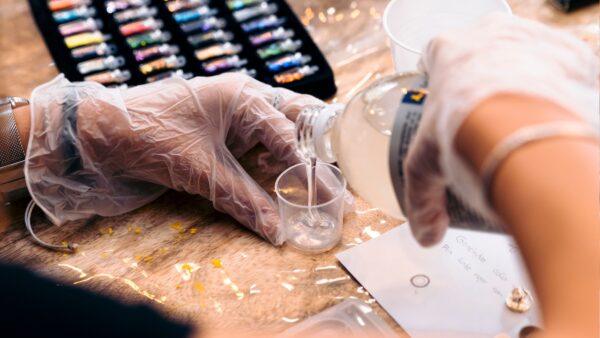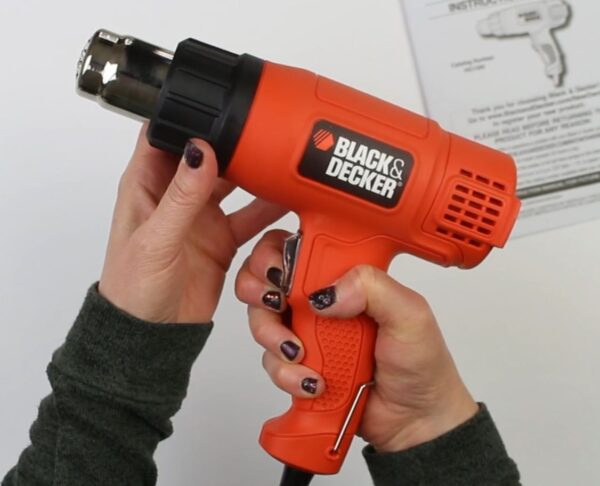How to make epoxy resin coasters [2025]
Welcome to a guide on how to make your own DIY resin coasters with epoxy resin.
Resin crafting is a captivating world of creativity, offering endless possibilities for making unique and functional pieces. In this coaster tutorial, you can make really cool resin coasters.
From striking geode-inspired coasters to flower resin coasters, resin crafting allows you to preserve cherished memories and create art that’s both beautiful and practical.
In this coaster DIY, we’ll show you coaster making for beginners and professionals.
Join us as we show you the techniques, materials, and design ideas to help you craft your very own custom resin coasters that will add a touch of artistry to your living space.
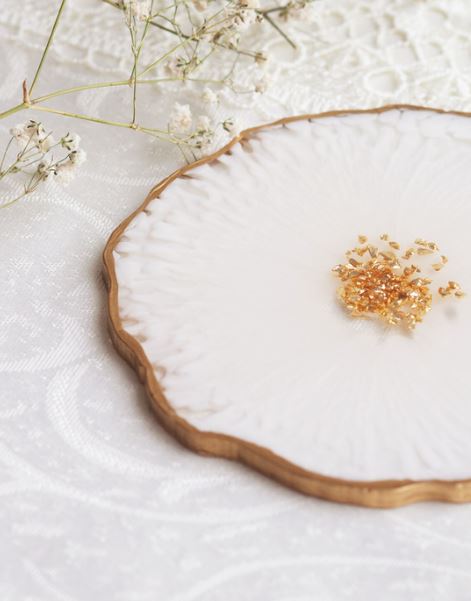
Whether you’re just starting out with resin crafting or you’ve been whipping up DIY resin art coasters for a while, there’s plenty of inspiration in store for you. If you’re new to this, don’t worry – it’s all about having fun and getting creative.
Resin coasters are like a playground for your imagination. For the seasoned crafters out there, you can take this opportunity to experiment with new ideas or techniques. The joy of making these coasters is in the process itself, and there’s no limit to what you can create.
How to Make DIY Resin Coasters
1. Introduction to Resin Coasters: Getting Started
Resin coasters are simply round or square coasters made by pouring a special type of clear, liquid resin into a mold. This resin, when cured, creates a hard, shiny, and durable surface that protects your tabletops from heat, moisture, and spills.
The exciting part is that you can customize them to your heart’s content. You can add colors, glitters, and even tiny decorations like dried flowers or glittery flakes to make them unique and stylish.
Once you’ve poured the resin into the mold and let it cure, you’ve got yourself a set of personalized coasters that can both serve their functional purpose and make your tabletops look fantastic. It’s a simple, creative, and practical DIY project that anyone can try.
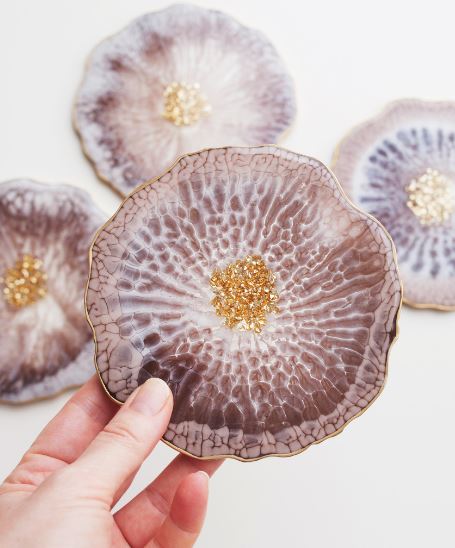
Epoxy resin, a versatile liquid, forms the core of this craft, acting as the canvas for encapsulating, the materials. You can use it to protect and display items resin flower designs, mica pigments, small treasures, and decorative add-ons.
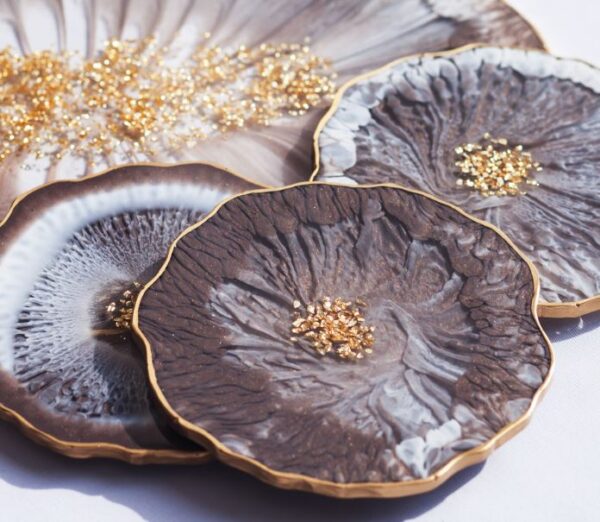
Getting started with epoxy requires a basic understanding of the materials and techniques involved. In this guide, you’ll learn about the types of resin to use for coasters.
We’ll share materials you’ll require, including molds, measuring instruments, and safety gear to have and safe crafting process. Once you’ve established this strong groundwork, you’ll be on your path to producing exquisite resin coasters.
2. Choosing the Right Resin for Your Coasters
When it comes to DIY coasters, choosing the right resin is a pivotal choice that can greatly impact the final results of your craft.
The initial stage in crafting resin coasters involves familiarizing yourself with the various resin options and the distinct qualities that each variant brings to the table
When it comes to DIY coasters, selecting the appropriate resin type will affect the outcome of your craft.
There are many different kinds of resin like UV resin, epoxy resin and polyester resin. This DIY coaster guide will be using two part epoxy resin. Some popular brands are Art ‘N Glow and ArtResin. These are a two part resin ratio so they are really easy to use.
Here are Two More brands we use For making Coasters
Thicker resins like these are ideal for embedding glitter, leafing and flowers. Additionally, you must factor in the working time you have before the resin begins to harden. These two resins are some of the easiest to work with when making coasters.
Another key element to consider is the clarity of the resin. Some resins may have a slight yellowing or may not be entirely crystal clear. Clarity is a must, especially when working with translucent or transparent elements in your crafts, as it affects the final appearance of your pieces.
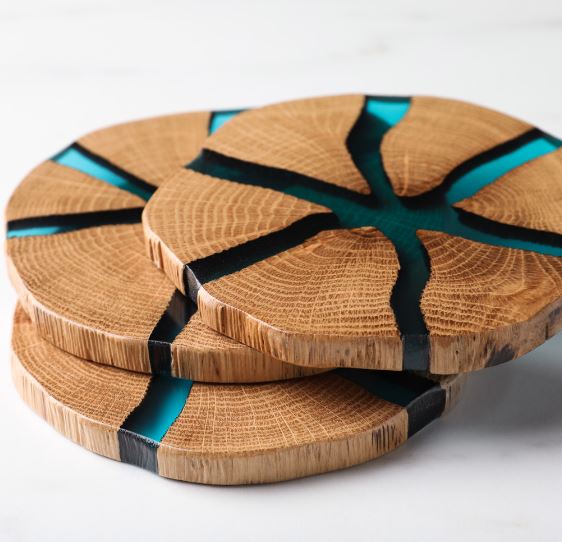
Quick Tips For Choosing Resin For Coaster Making
- Purchase resin that has a reputation of being crystal clear
- Choose epoxy resin that doesn’t create a lot of bubbles when stirring
- Thicker resins will hold embedded objects better
- Look for resin that is formulated to be yellow resistant.
3. basic steps and instructions for making Coasters
Gather Your Supplies
Collect the necessary materials, including epoxy resin, molds, inclusions such as dried flowers or glitter for resin flower designs. You will also need pigment or dyes, mixing cups & stirring sticks.
A heat gun or torch will help remove bubbles.
And personal protective equipment which include gloves, safety goggles, and a proper resin mask.
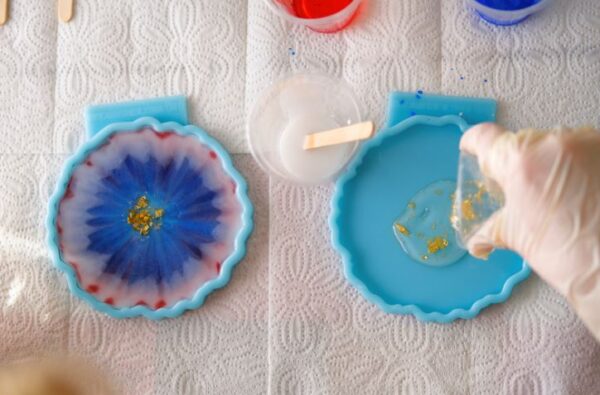
Prepare Your Workspace
Set up a clean, organized, workspace with a flat surface. Cover your work area with a disposable tablecloth or plastic sheet to catch any drips or spills. Resin can be very messy, especially if this is your first time using it.
Measure and Mix the Resin
Follow the manufacturer’s instructions to measure and mix the resin and hardener components in the designated mixing cups. Typically, this involves using a 1:1 ratio by volume or weight.
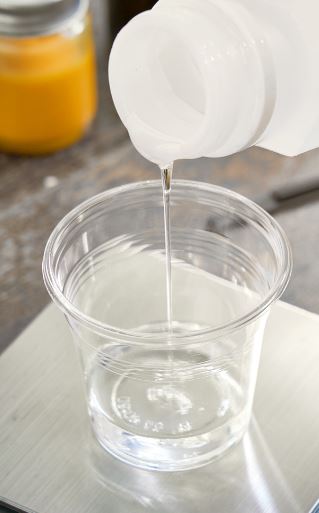
Add Pigments or Inclusions
If you want to color or inclusions to your resin, add pigment or dye in small amounts. Mix well until you achieve your desired color.
Just be sure not to oversaturate the resin as it can cause it to seize. You can also sprinkle glitter or inclusions onto the piece after you have poured the resin in to the mold. Totally up to you.
Some popular inclusions to add to coasters are:
Alcohol Inks: These vibrant inks come in a wide range of colors and can create stunning, translucent effects within your resin.
Mica Powders: Mica powders provide a shimmering, metallic appearance to your coasters and are available in various metallic shades.
Glitter & Gold Leafing: Add a touch of sparkle to your coasters with fine or chunky glitters and gold leafing elements. For more ideas, check out our article: Gold ideas to use in resin.
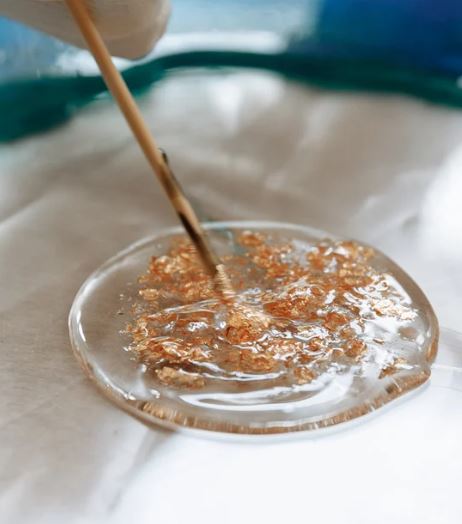
Dried Flowers: Pressed or dried flowers can bring a touch of nature to your coasters, creating a beautiful, organic look.
Ink or Acrylic Paint: Mix a small amount of ink or acrylic paint to achieve vibrant and opaque colors, allowing for intricate designs and patterns.
Pour Resin into Molds
Carefully pour the mixed resin into your chosen molds. Fill the molds to the desired depth, taking care not to overfill.

Add Inclusions
If you’re embedding objects or inclusions, use tweezers or a toothpick to arrange them within the resin. Adjust their position until you’re satisfied with the design. For those who are learning how to make resin coasters with flowers, now it the time to add those in.
Remove Air Bubbles
Again, use a heat gun or torch to pass over the resin’s surface to release any remaining air bubbles. Be gentle and maintain a safe distance to avoid overheating the resin.
Cure Time
Allow the resin to cure as per the manufacturer’s recommendations. This usually involves letting it sit undisturbed for several hours or overnight if using epoxy resin. We have a super helpful article all about resin cure times.
Demold and Finish
Once the resin is fully cured and hardened, gently demold your pieces. You may need to flex silicone molds to release the items. After demolding, you can sand, polish, remove any sharp edges, and add finishing touches.
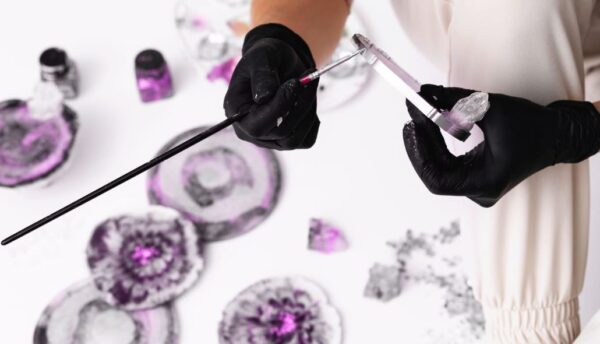
With these basic steps and some practice, you can create beautiful coaster pieces. Remember to follow safety guidelines, be patient, and experiment with different designs and techniques to develop your skills and style.
4. Supplies for Coaster Making
Creating resin coasters is a fun craft, but to embark on this creative journey successfully, you need the right tools and supplies. In this guide, we’ll explore the items you’ll require to start crafting beautiful pieces.
Resin: This is the core material for your coasters. The brands we mentioned above are perfect for this type of craft.
Safety Gear: Safety should be your top priority when working with resin. Always wear gloves, a well-ventilated mask, and protective eyewear to avoid skin contact and inhaling fumes.
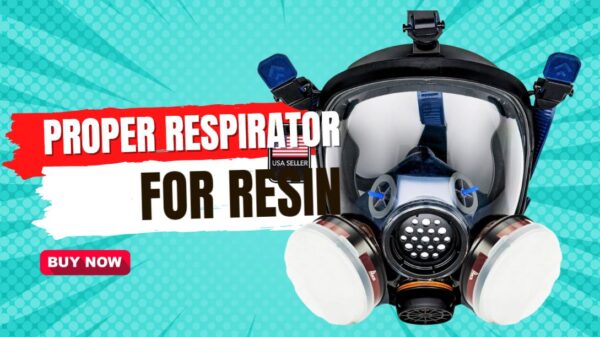
Molds: Molds come in various shapes and sizes and made for creating specific designs like the popular epoxy resin flowers. Silicone molds are popular due to their flexibility and ease of release.
Molds are budget friendly and you can also get a complete set that comes with extras. We dive into molds and how to choose the right one for your project below.
Inclusions & Embeds: Collect and prepare the inclusions, which can include dried flowers, tiny charms, glitter, or other decorative elements.
If you are making resin coasters with flowers, sometimes you might want to add some extra glitter or polymer clay embeds to go with it.

Measuring Tools: Use digital scales or graduated mixing cups to measure the resin components accurately.
Mixing Containers: You’ll need containers for measuring and mixing the resin. The best mixing containers are silicone as they can be reused many times to reduce waste and money.
Pigments and Dyes: If you wish to add color to your resin, various pigments, and dyes are available. These allow you to achieve vibrant, custom hues.
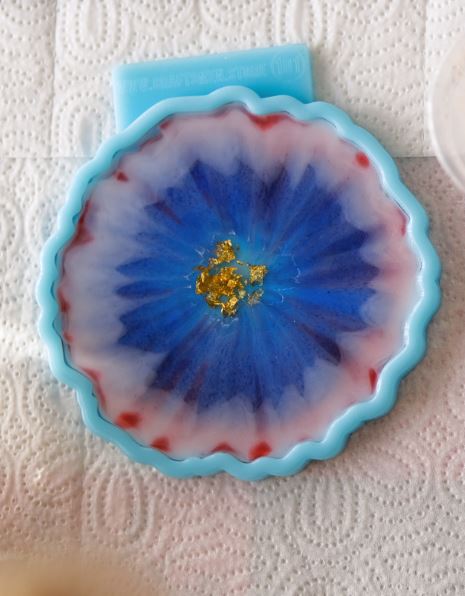
Stirring Sticks: Wooden or plastic stirring sticks are for mixing the resin and any added pigments or dyes.
Heat Gun, Torch Or Bubble Removal Tools: Removing air bubbles will give you a smooth finish. A heat gun or torch helps to eliminate bubbles that form during the mixing process. Also, a bubble remover will remove the bubbles from the mixing cup before pouring.
See our guide on how to get rid of bubbles in resin coasters.

Sanding and Polishing Supplies: Once your resin pieces have cured, you may need sandpaper and polishing compounds to refine the surface and achieve a high-gloss finish. This will also get rid of any ridges when unmolding.
Having these resin supplies on hand is helpful so you’re well-prepared to create resin art. While there may be additional tools and materials specific to certain projects, this list forms the foundation of your resin crafting stash.
5. Safety Precautions When Working with Resin
When working with resin, prioritize safety: work in a well-ventilated area and wear a respirator to avoid inhaling fumes, use gloves and safety goggles to protect your skin and eyes.

Have a dedicated workspace, avoid direct contact with resin on your skin, and handle chemicals with care.
Additionally, always read and follow the manufacturer’s instructions for the specific resin you’re using for safe handling, proper disposal of waste, and compliance with safety guidelines.
6. Adding Color to Epoxy Coasters: Dyes, Pigments, and Inks
Color is a vital element in creating coasters, allowing you to infuse your creations with vibrancy and personality. When it comes to adding color to your resin, you have several options, including dyes, pigments, and inks, each with its unique properties and techniques.
Dyes: Resin dyes are ultra-concentrated liquid colorants meticulously formulated for resin applications. They deliver vivid, see-through shades that are simple to blend and manage.
To make the most of these dyes, simply introduce a few drops into your resin mixture and stir until it’s incorporated.
Dyes are ideal for achieving translucent, stained glass-like effects. They’re especially popular when you want to preserve the clarity and transparency of the resin while introducing color.
Check out our helpful guide about the best colorants to use for resin.

Pigments: For resin coasters, it’s important to note that resin pigments are available in both liquid and powder variants. These pigments provide a wide spectrum of color options and are particularly suitable when you aim to achieve opaque or solid-colored designs in your coasters.
They’re commonly utilized to establish solid backdrops or vibrant layers in resin coasters.
When working with pigments, it’s advisable to introduce them to your mixed resin gradually, as even a small quantity can yield rich colors.
The amount of pigment you add will directly impact the color’s intensity in your coasters.
Mica powders are some of the mots popular pigments to use. Read up on the best mica for epoxy and also our mica colorant guide on how to use it.

Inks: Alcohol inks are a favored option when it comes to incorporating intricate patterns and designs into resin. These inks come in a diverse array of colors, making them adaptable for generating abstract or marbled visual effects.
When working with alcohol inks, apply them in modest drops or streaks directly onto the resin surface, letting them naturally diffuse and blend.
You can shape and customize the inks using tools such as toothpicks or straws to craft one-of-a-kind patterns.
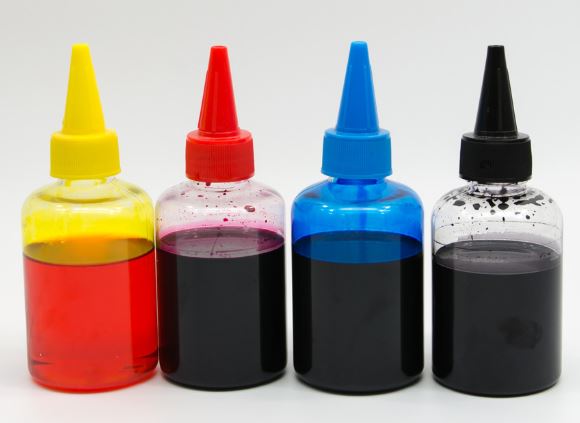
Glitter: Glitter is a widely embraced selection for infusing a touch of shimmer and captivating allure into resin works.
Thanks to its reflective characteristics and capacity to capture and disperse light, it stands out as a top choice to achieve a brilliant and attention-grabbing impact in resin pieces.
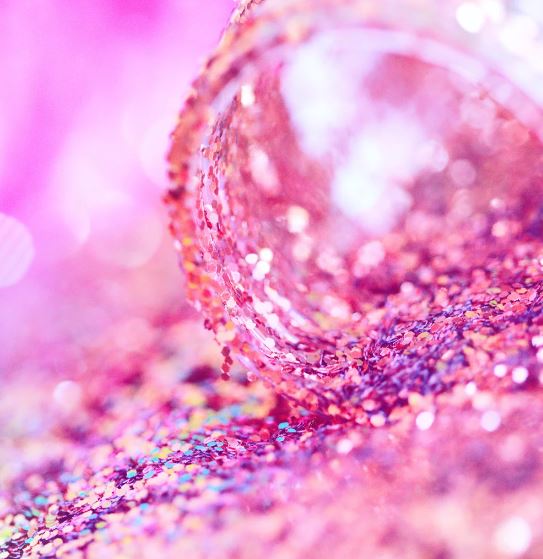
Experimenting with these coloring agents allows you to explore different artistic possibilities.
Remember that less is often more when adding color to resin; starting with a small amount and gradually adding more if needed.
Additionally, practicing on small, disposable projects can help you refine your technique before working on your main pieces. Resin can be pricey so you can save money by practicing on something smaller until you get the hang of it.
7. Working with Molds: Creating Unique Shapes and Designs
Molds are one of the things that will help you to make resin coasters. Whether you’re a beginner or an experienced crafter, understanding how to work with molds is key to crafting unique shapes and designs.
Mold Selection: The first step in working with molds is choosing the right one for your project. Silicone molds are popular for their flexibility, ease of use, and ability to produce intricate details. They are the most popular for resin flower designs.
They come in various shapes and sizes, including those designed specifically for geode coasters and resin flower coasters.
Additionally, you can create your custom molds using silicone putty and free pour your own molds once you get to know how long you have until the epoxy will not pour anymore.
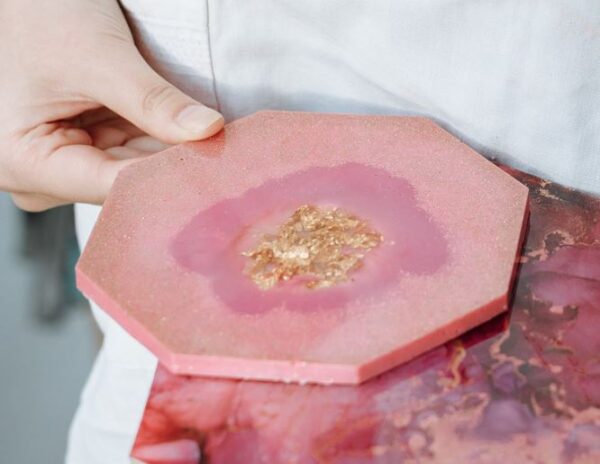
Mold Preparation: I have found that working with the resins mentioned above, I did not need to use a release at all. But some resins don’t work as well.
If you are worried about it, apply a mold release agent to the mold’s interior surfaces. This minimizes the risk of the resin adhering to the mold and simplifies the demolding process.
When using silicone molds, the resin will normally just pop out without having to do any prep.
Pouring Resin: When you’re ready to pour the resin, follow the manufacturer’s instructions carefully. Pour slowly and steadily to prevent air bubbles from forming. Depending on your design, you may pour multiple layers of resin to create depth and dimension within the mold.
Adding Inclusions: If incorporating elements like flowers, beads, or charms into your design, your choice depends on whether you want to place them within the mold before pouring the resin or sprinkle them atop the resin surface.
The selection should align with the nature of the materials you’re using. Delicate, fine elements, like glitter, will tend to rest on the resin’s surface, while heavier embeds will naturally settle closer to the bottom as the resin cures.
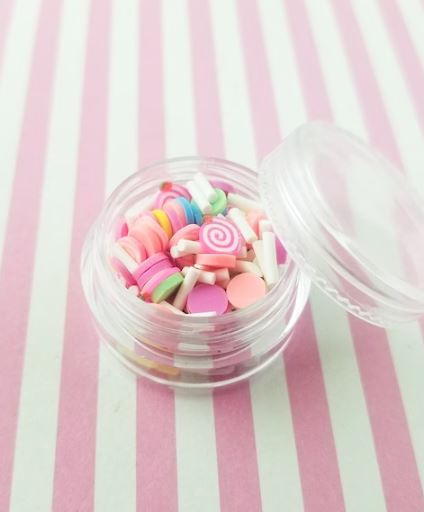
Demolding: Once your resin has fully cured, it’s time to remove it from the mold. Gently flex the silicone mold to release the resin. Patience and a delicate touch are key during this step to prevent any harm to the cured resin.
Finishing Touches: Once removed from the mold, your resin pieces may have sharp edges or imperfections. Use sandpaper and polishing compounds to smooth the edges and achieve a glossy, professional finish.
Experimentation: Don’t hesitate to explore and try new things. Experiment with various mold shapes, sizes, and techniques. You can play with layered designs, merge multiple molds into a single piece, or venture into the world of translucent and opaque layers to produce captivating and unique effects.
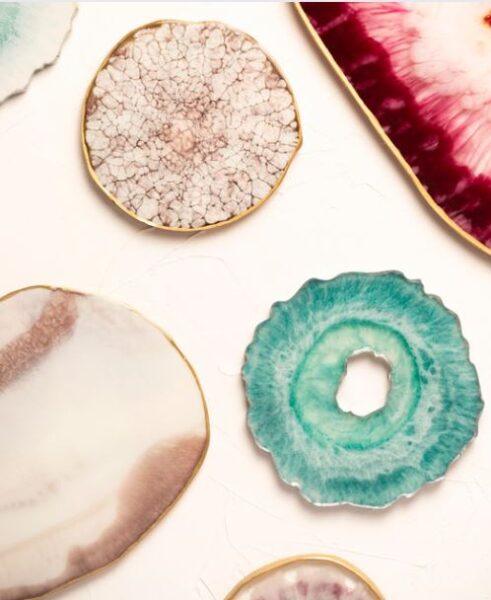
8. Embedding Objects in Resin Coasters
One of the most fascinating aspects of crafting resin coasters lies in the power to preserve treasured items and cherished memories in your creations.
Be it a fragile bloom, a precious memento, or any small, sentimentally significant item, the act of embedding these objects in resin can elevate them into profoundly personal and heartfelt pieces. You can also use scrapbooking papers or photos as long as you seal the paper for resin first.
Choosing What to Include: The initial step in embedding objects in resin involves selecting the items you wish to encapsulate. Your choices can span from dried flowers, leaves, feathers, or tiny gemstones to meaningful keepsakes like locks of hair, miniature photographs, fragments of jewelry, or even a sprinkle of glitter or gold leafing.
These inclusions bestow a unique, personal character upon your coasters, ensuring that each piece tells a one-of-a-kind story.
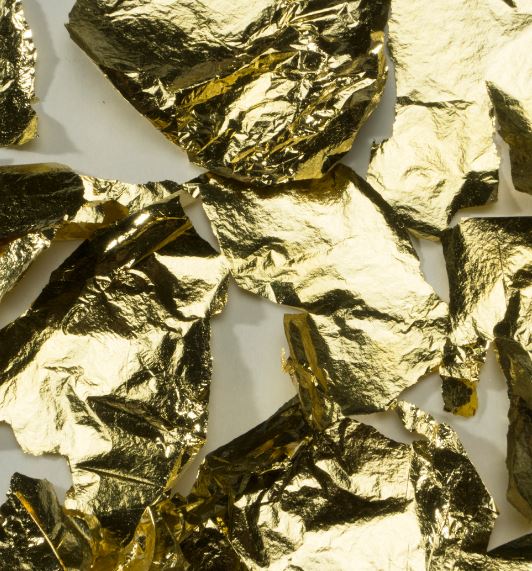
Preparing Objects: Properly preparing the items you intend to embed in your coasters is important.
If you’re using organic materials like flowers or leaves, they must be fully dried and free from any moisture to prevent decay within the resin.
Layering and Positioning: Plan your design by deciding how you want to arrange and layer your inclusions within the mold. Be precise when positioning the objects, as adjustments are not possible once the resin is cured.
Pouring Resin: Follow the manufacturer’s instructions for mixing and pouring the resin over your inclusions within the mold. Pour it slowly to avoid trapping air bubbles, and use a toothpick or a small tool to arrange the inclusions within the resin, ensuring even distribution in your coasters.

Curing: Allow the resin to cure for the recommended time. During this phase, the resin gradually hardens and turns transparent, beautifully showcasing the objects you embedded within your coasters.
Demolding and Final Touches: Once the resin has completely cured, gently release your piece from the mold. Exercise patience and care to avoid any harm to the resin or the embedded items. Following demolding, you might need to refine the edges and surfaces by sanding and polishing to achieve a polished and professional finish.

Embedding objects in resin not only adds an artistic dimension but also allows you to preserve cherished memories and keepsakes. While you explore various inclusions, molds, and design concepts, you’ll discover that the possibilities are limited only by your creativity and imagination.
9. Perfecting Resin Casting and Embedding
Resin casting and embedding stand as foundational techniques in resin coaster crafting, offering the means to craft intricate designs, safeguard delicate elements, and introduce depth to your creations.
Achieving mastery in these skills hinges on practice, meticulous attention to detail, and a comprehensive grasp of the procedures.
Materials and Tools: To excel in resin casting and embedding, your first step involves sourcing top-quality materials and tools.
Begin by selecting the appropriate resin for your project, ensuring that you have the right molds, and gathering all supplies like stirring sticks, measuring cups, and safety equipment.
Design and Preparations: Careful design and planning should precede your resin casting and embedding endeavors. Write down your thoughts about placement of inclusions, the consideration of multiple layers, and any desired special effects.
Develop a well-thought-out project plan that will function as your roadmap throughout the crafting process.
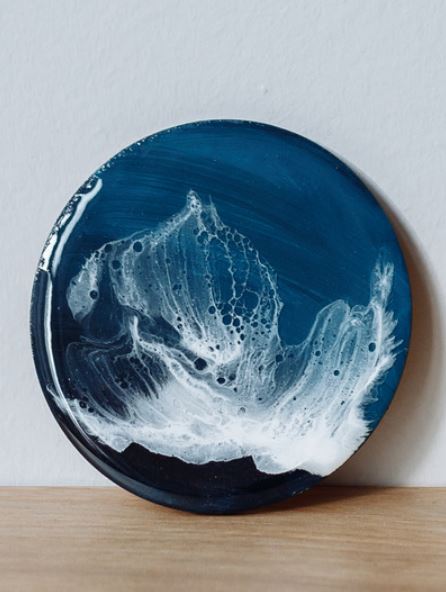
Blending and Pouring Resin: Precise resin mixing is paramount. Adhere to the manufacturer’s guidelines for your particular resin variety, and utilize measuring tools to maintain exact proportions.
Stir the resin meticulously, but steer clear of overly vigorous mixing, as it may introduce unwanted air bubbles. When it comes to pouring, maintain a methodical and consistent approach to minimize bubble formation and guarantee even dispersion.
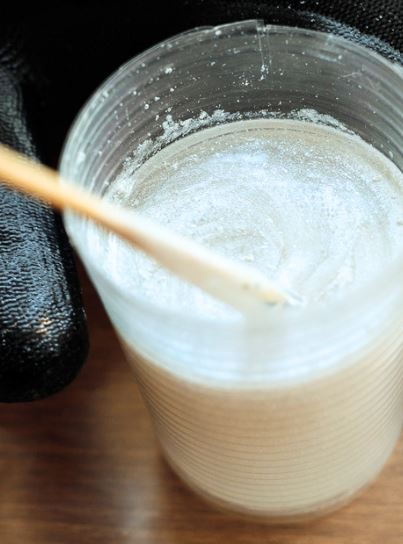
Layering and Timing: Crafting multi-layered designs is a standard practice in resin casting and embedding. Let each resin layer partially set before introducing the next.
This approach prevents color bleeding or inclusions from settling at the bottom. Pay heed to timing, as different resins may exhibit diverse pot times and curing periods.

Ongoing Progress: The pathway to mastering resin casting and embedding revolves around consistent practice and gleaning insights from every project.
Don’t be disheartened by initial imperfections; they serve as invaluable learning opportunities.
With time, you’ll cultivate an instinct for timing, bubble management, and design realization, ultimately culminating in the creation of outstanding resin coasters.

Resin casting and embedding are versatile techniques that open the door to endless creativity.
As you refine your skills and experiment with various designs, you’ll discover the joy of crafting intricate, personalized resin pieces that tell your unique story and captivate those who admire your creations.
10. Easy DIY Resin Coasters for Beginners: Simple Projects to Start With
For those new to resin coaster crafting, there’s no need for overwhelm. Commencing with uncomplicated projects is an excellent strategy for acquiring fundamental skills and boosting your confidence. Here are a few easy resin coaster projects tailored for beginners:
Pink Resin Coasters:
Here are the materials needed to make these coasters:
- Epoxy resin
- Silicone coaster molds
- Gold leaf
- Pink mica powder
- White mica powder
- Gold paint
- Mixing cups and sticks
- Heat gun
- Safety gear (gloves and mask)
Getting Started: Measure and mix the epoxy resin according to the manufacturer’s instructions. Stir thoroughly. Slowly add white mica mixing until you achieve the desired color. Next add the pink colorant a bit at a time. For a marbled look, do not fully incorporate the color.
Pour the resin mixture into the silicone coaster molds, tapping them gently to release any trapped air bubbles. Use a heat gun or lighter to eliminate remaining bubbles on the surface.
Sprinkle on the gold leaf and let it settle into the resin. The gold leaf must be totally coated with resin.
Allow the coasters to cure as per the manufacturer’s instructions, then demold carefully and finish off the edges with gold paint.

Botanical Resin Coasters:
Here are the materials needed to make these coasters:
- Epoxy resin
- Large silicone coaster molds
- Dried flowers, leaves, or small decorative elements
- White liquid pigment
- Mixing cups and sticks
- Tweezers (for precise placement)
- Heat gun
- Safety gear (gloves and mask)
Getting Started: Put on your safety gear. Measure and mix the epoxy resin according to the manufacturer’s instructions and add in the white pigment.
Slowly pour the mixed resin into the mold. Gently place dried flowers, leaves, or other decorative elements in the silicone coaster molds using tweezers for precision. After they’ve fully set, demold the coasters with care.

Mesmerizing Geode Resin Coasters:
Here are the materials needed to make these coasters:
- Epoxy resin
- Silicone coaster molds (geode shape)
- Metallic or translucent mica powders
- Glitter
- Crushed glass or small gemstones
- Mixing cups and sticks
- Heat gun
- Safety gear (gloves and mask)
Measure and mix your epoxy resin according to the manufacturer’s instructions. For this DIY you will need to mix enough to have several colors. To mimic the geological layers of a geode, first pour a thin layer of clear resin into the silicone geode molds.
Then pour your other colors into the mold in a circle to look like a geode. You can decide if you want to add glitter into the mixing cups, or sprinkle it onto the resin once it is in the mold.
Follow with crushed glass or small gemstones to create the crystalline effect. Do be sure that they do not stick up over the resin or a cup will not sit level.
Use a heat gun or lighter to eliminate any surface bubbles. Let the coasters cure as per the manufacturer’s recommendations and, when fully set, demold your mesmerizing geode-inspired resin coasters. And finish off the edges.
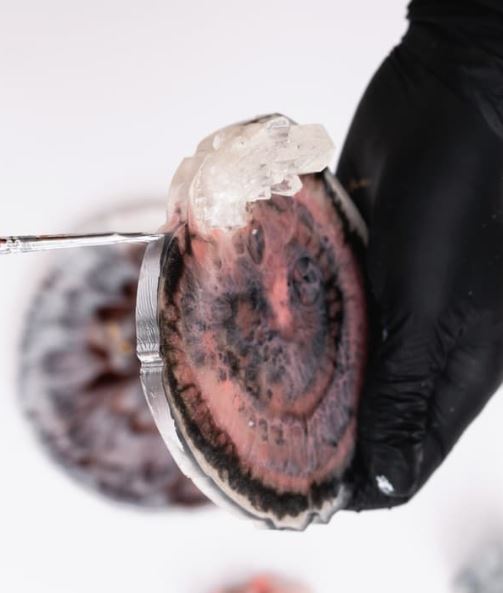
As your confidence and expertise grow, you can venture into more intricate techniques, including embedding objects, experimenting with pigments and dyes, and working with multiple layers.
11. The Most Popular Types Of Coasters To Make
- Geode Resin Coasters: Geode-inspired coasters mimic the intricate layers and vibrant colors found in natural geodes, creating mesmerizing and eye-catching pieces.
- Beach-Themed Resin Coasters: These coasters often feature tiny seashells, sand, and vibrant ocean hues, evoking the tranquil beauty of the seaside.
- Botanical Resin Coasters: These coasters encapsulate dried flowers, leaves, and other natural elements, preserving their beauty and bringing a touch of nature to your table.
- Abstract Resin Coasters: Abstract designs offer creative freedom, often involving vibrant alcohol inks or unique color combinations that result in visually striking and unpredictable patterns.
- Glitter Resin Coasters: Glitter coasters add a touch of sparkle and opulence, with shimmering elements that catch and reflect light for a dazzling effect.
- Terrazzo Resin Coasters: Inspired by the classic terrazzo flooring, these coasters incorporate a variety of colorful chips and fragments within the resin for a stylish, modern look.
- Marble Resin Coasters: These coasters mimic the elegance of marble, with swirling colors and intricate patterns that add a touch of luxury to your decor.
- Wood and Resin Coasters: Combining natural wood and resin, these coasters juxtapose organic warmth with the glossy elegance of resin, resulting in a harmonious and contemporary design.
- Epoxy Resin and Ink Coasters: By mixing epoxy resin with vibrant alcohol inks, you can create a fascinating blend of translucent colors and unique abstract designs.
- Nautical Resin Coasters: Nautical-themed coasters often feature sea-inspired elements such as seashells, starfish, and sailboat motifs, bringing a coastal charm to your tabletop.
Each of these resin coaster types offers a distinct and visually appealing way to express your creativity and enhance your home décor.
12. Will my coaster turn yellow?
Resin coasters have the potential to develop a yellowish hue over time, with the extent of color change contingent upon several factors. These factors include the specific resin type employed, the degree of UV light exposure, and the quality of both the resin and pigments involved. Here are essential considerations to keep in mind:
Resin Type: Resin variations, such as epoxy and UV resin, exhibit differing tendencies regarding yellowing. Epoxy resin, commonly used in coaster crafting, can be more susceptible to yellowing when exposed to UV light over an extended period, whereas UV resin is typically less prone to this effect.
UV Exposure: Ultraviolet (UV) light exposure, encompassing sunlight and indoor fluorescent lighting, is a primary catalyst for resin yellowing. Over time, UV rays can trigger a chemical reaction within the resin, leading to the development of a yellowish tint.
Resin Quality: The quality of the resin utilized can significantly influence its resilience to yellowing. Superior-quality resins are often formulated to withstand yellowing and maintain clarity over an extended duration.
Pigments and Additives: The choice and quality of pigments, dyes, or additional additives introduced into the resin mix can exert a notable impact on the likelihood of yellowing. Some pigments and dyes possess greater stability, rendering them less susceptible to fading or color alteration.
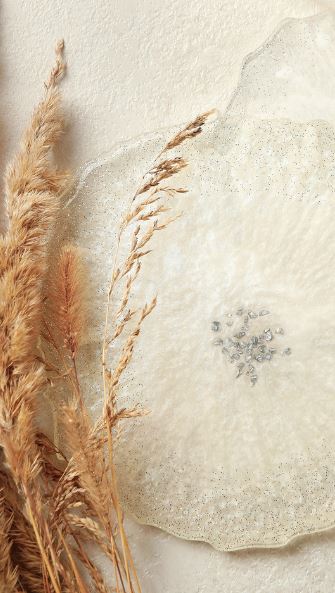
Minimize Yellowing In Resin
- Use UV-resistant resin if you’re concerned about yellowing.
- Store your creations in a cool, dark place when not in use to minimize exposure to UV light.
- Avoid excessive heat, as high temperatures can also accelerate yellowing in some resins.
- Consider using pigments and additives that are known for their resistance to fading and yellowing.
It’s important to note that even with precautions, epoxy resin may still yellow to some extent over a long period. However, UV-resistant or UV-stabilized resins are less prone to yellowing and are a good choice for preserving the clarity and color of your resin coasters over time.
More more information and questions about yellowing here’s our guide: Why Does Epoxy Resin Turn Yellow
13. Do you have to seal resin?
No, typically, you do not need to seal resin-coated coasters once they have fully cured. Resin, particularly epoxy resin, is designed to create a protective and glossy finish on its own, eliminating the need for additional sealing in most instances.
Nevertheless, if your coasters include delicate inclusions such as paper, it’s advisable to shield it by applying a sealant before casting them in resin so that the ink does not run.
One recommended paper sealer is Annie Howes, which has been known to work effectively without causing ink bleeding. Always conduct a compatibility test to make sure that it suits your specific inks and materials.
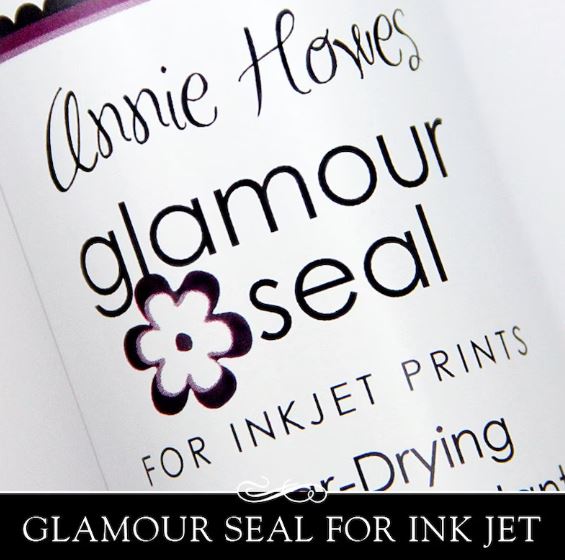
In conclusion, we hope this information has been helpful and informative on your journey to crafting stunning resin coasters.
Remember, resin crafting is an art that combines creativity and skill, offering endless possibilities for design and personal expression. We hope you learned some great tips on how to make coasters with resin.
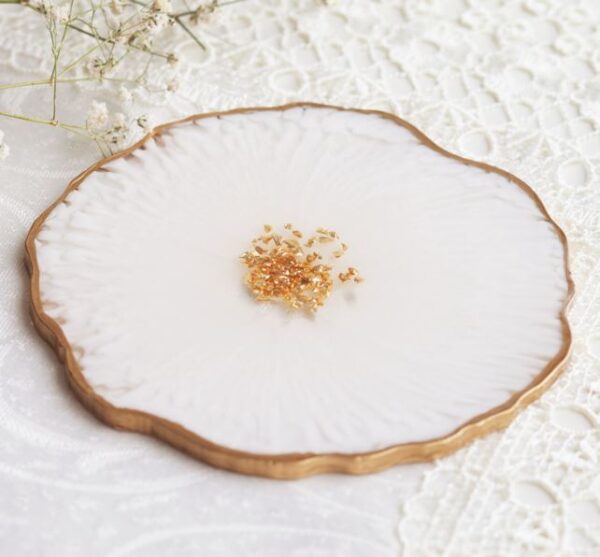
With practice and the right techniques, you can create beautiful, functional pieces that add a touch of artistry to your home. Thanks for reading, and we wish you the best of luck in your resin coaster crafting!
Next, read our guide on how to make handmade resin magnets.
